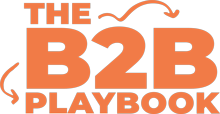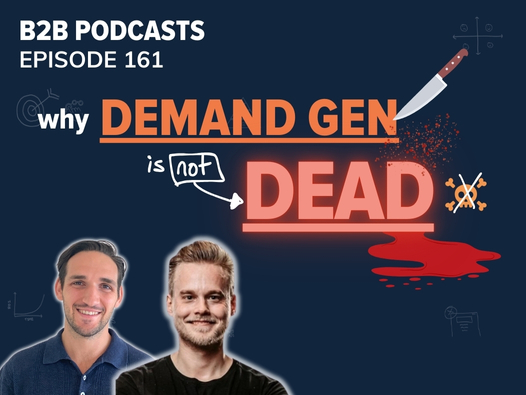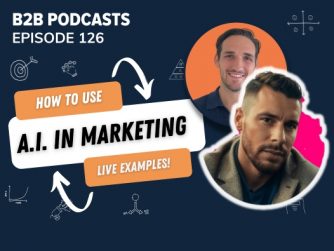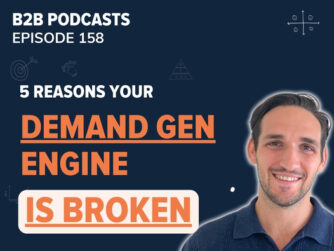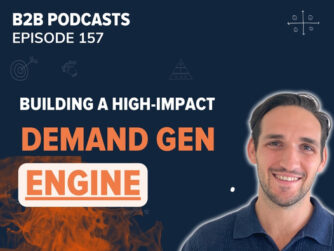In our little corner of the world in LinkedIn, Demand Generation has become a bit of a buzzword. You see debates popping up across LinkedIn, with some claiming demand gen is dead—or worse, that it’s no different from lead generation. But if you’re part of the modern Demand Gen movement, you know that couldn’t be further from the truth. Demand gen is so much more than just “getting leads.” It’s about creating real connections with your audience, building trust over time, and setting up your brand to be the first thing that comes to mind when they’re ready to buy.

In this article, we’re diving deep into what makes demand generation such an essential part of modern B2B marketing. We’ll address the common misconceptions and show you exactly how demand gen can transform your brand’s approach. From bridging the gap between sales and marketing to building brand loyalty that lasts, we’ll cover it all with Fibbler Co-Founder Adam Holmgren.
Stick with us, and you’ll see why demand generation isn’t just alive—it’s the future of sustainable B2B growth.
Listen To The Episode
Watch The Episode
Demand Generation vs. Lead Generation: Clearing Up the Confusion
There’s a misconception floating around that demand generation and lead generation are the same thing. Three to five years ago, ‘Demand Generation’ may have meant lead generation to many marketers. However it has since evolved to be about so much more than cranking out leads. Demand gen focuses on building brand trust and loyalty over time, making sure that when potential buyers are ready, they think of you first.
As Adam puts it,
“Demand generation and lead generation are not the same thing…Demand gen is about building brand trust with potential customers”
Adam Holmgren – The B2B Playbook – [00:03:10]
Lead gen might be about getting that immediate conversion, but demand gen plays the long game, prioritizing relationships over quick wins.

Think of it like this: demand generation is about creating a memorable, trusted brand that customers keep coming back to. We’re not just targeting MQLs; we’re aiming for true revenue opportunities. This is a major pivot from the traditional lead gen model, where the focus was on getting names into the pipeline as fast as possible. With demand gen, it’s not just about filling up your CRM, it’s about creating meaningful connections that translate into revenue down the line.
Demand gen does this by operating on two levels: building trust with future buyers, and capturing existing demand with current in-market buyers. This dual role means you need to think about getting your brand in front of the right people before they’re even in the market, so that when the time comes, they already know and trust you. Capturing demand means identifying and engaging with the smaller group who are ready to take action now. Both are part of a well-rounded demand gen strategy, but they serve different functions—something traditional lead gen just doesn’t cover.
Ultimately, demand gen is less about pushing for quick sales and more about fostering long-term brand affinity.
Shaping Future Demand vs. Capturing Demand
A lot of marketers still get hung up on demand gen’s dual focus: shaping future demand versus capturing it. Shaping future demand (sometimes referred to as ‘creating demand’) is about getting your brand in front of people long before they’re ready to make a purchase, so that when they are ready, your brand is already top of mind. We’re not pushing for the quick win here; we’re setting the foundation, building brand affinity, and establishing ourselves as the go-to solution well before the need arises.
The modern demand generation marketer needs to work to connect their brand with real customer problems, even when they’re not actively seeking a solution. It’s about saying, “Hey, we understand your challenges and we’re here to help—even if you’re not ready to buy right now.”
I see it as creating affinity for your brand, so when those people come into market, they think of your brand first. Imagine it like this: if I spill red wine on my shirt, I know I need a stain remover, and I’ll probably think of Vanish first. They’ve positioned themselves as the go-to for that problem. In the same way, a great demand gen strategy makes sure that when a prospect has a specific challenge in their business, your brand is the first that comes to mind.
On the other hand, capturing demand is where we start converting that trust into tangible results. This part of the strategy is focused on the prospects who are already showing interest, who are a bit closer to the buying decision. Capturing demand means recognizing that someone is actively looking for a solution and making it easy for them to find you. In this stage, “putting in a little bit of friction to reveal a person to then speak to the sales side” helps us engage the right prospects at the right time. The demand capture side is about identifying those who are ready to take action now and nurturing them into high-quality leads.
Together, creating and capturing demand form a powerful one-two punch. The work you do on the branding side makes the capturing part that much easier.
Building Brand Awareness: A Core Component of Demand Gen
When it comes to demand generation, brand awareness is the backbone of everything we do. As Adam put it,
“The entire basis of demand gen is about understanding your audience and building trust with them…within the problem area you are solving with your product”
Adam Holmgren – The B2B Playbook – [00:07:40]
In demand gen, brand awareness means becoming part of the buyer’s mind long before they even start searching.

A huge part of this is working with the 95-5 rule: the idea that 95% of our market isn’t ready to buy today. As demand gen marketers, we spend most of our energy on those future buyers. Building brand awareness means showing up consistently, so that when those buyers do enter the market, we’re the brand they remember.
It’s also about creating connections between our brand and specific challenges. If a marketer is struggling to prove the ROI of LinkedIn ads, Adam would of course want them to think of Fibbler as the solution. This is what is referred to as “category entry points” by Professor Jenni Romaniuk. Our job in demand gen is to align our brand with those category entry points, making sure we’re top of mind whenever a relevant problem crops up.
The 5 Stages of Awareness: Framework for Demand Gen
One of the frameworks we rely on in demand gen is the 5 Stages of Awareness. It’s simple but powerful. This framework helps us understand where our audience is in their buying journey and meet them there.
When marketers refer to ‘category entry points’, these are people that we would refer to as ‘problem aware’ in The 5 Stages of Awareness. I.e. people who have had an event happen to them, and it’s made them realise that there’s a problem that needs to be solved.

And this isn’t just about getting them to recognize our brand—it’s about creating what we call “memory structures,” so people think of us automatically when their problem arises.
You can learn more about The 5 Stages of Awareness and how we use it here.
Leveraging Signals and Data in Demand Generation
The modern Demand Generation marketer is able to leverage signals and data. These are clues into what’s happening with our audience, but they’re not the same as traditional lead scoring. When we track engagement, we’re looking for signals that tell us someone is interested—not just ready to buy. Instead of pushing them straight to sales, demand gen takes a more nuanced approach, focusing on meaningful interactions.
This approach to signals allows us to build rapport in a way that feels natural. As Adam says, imagine a prospect visits the Fibbler website. Rather than bombarding them with emails, a demand gen approach might be as simple as connecting on LinkedIn, so they’re exposed to more helpful content over time.
Demand Gen as the Connector Between Sales and Marketing
Demand gen does something unique: it aligns sales and marketing like nothing else. When done right, demand gen acts as “the missing glue between sales and marketing,” as Adam calls it [00:18:10]. We’re not just running separate campaigns or funnelling leads to sales. Instead, we’re creating strategies that serve both departments’ goals, making sure marketing’s efforts lead to real business outcomes that sales can act on.
One way we create that alignment is by building direct connections with sales teams. Adam mentioned that he sits in on sales calls every week to bridge the communication gap: “I’m sitting in on sales calls every week…to try to understand, and vice versa” [00:18:30]. This type of collaboration means we’re constantly refining our strategy based on what sales actually needs. In demand gen, we’re not just marketers—we’re connectors, working to make sure everyone is pulling in the same direction.
Demand gen is perfectly positioned to act as that connective tissue between the business outcomes, sales, and marketing. By focusing on shared objectives, we’re ensuring that both teams work together toward common goals.
The Consultative Approach: Aligning Demand Gen with Buyer Needs
In demand gen, we don’t push our audience through a rigid funnel. Instead, we take a consultative approach, focusing on understanding and meeting buyer needs. Today’s B2B buyers prefer to control their journey, and demand gen respects that autonomy by removing friction wherever possible. This approach allows us to be a helpful guide rather than a pushy salesperson, putting the buyer in the driver’s seat.
A consultative approach means we’re there to support the buyer’s journey with relevant content, answers, and resources, whether they’re just beginning to research or actively evaluating solutions. For instance, Adam shared that his company’s goal is to “show the value right away” so prospects don’t have to jump through hoops to understand the benefits. This mindset creates a more engaging experience and builds trust because we’re making it easy for buyers to see how we can help without unnecessary barriers.
By adopting a consultative, buyer-centric model, demand gen becomes more than just a marketing strategy. We’re aligning ourselves with our audience’s needs and making it easy for them to choose us when they’re ready to buy. This approach not only improves the buying experience but also builds loyalty, positioning our brand as a trusted advisor rather than just another vendor.
The Lasting Impact of Demand Generation
Demand generation is so much more than a lead-generation machine—it’s a strategic approach that builds long-term relationships, aligns sales and marketing, and turns your brand into a trusted, go-to resource. The reality is, effective demand gen takes time, consistency, and a genuine focus on delivering value to your audience. As demand gen marketers, we’re not just filling the pipeline with MQLs; we’re creating a foundation that brings in loyal, well-informed buyers who already see us as the solution when the time is right.
If there’s one takeaway here, it’s that demand gen is about showing up and being useful, even before there’s a buying signal. We create demand not by pushing, but by guiding—through relevant content, consistent engagement, and by building trust with the 95% of our market that isn’t ready to buy today. This approach isn’t flashy, and it doesn’t promise instant wins. But if you’re in B2B marketing for the long haul, there’s no better way to establish a sustainable growth engine.
So, for those of you ready to level up your demand gen game, the message is simple: focus on building relationships, bridge the gap with sales, and create a brand that buyers remember. When you prioritize the long game and lean into the consultative approach, you’re setting your brand up not just to capture demand, but to create it. That’s the true power of demand generation.
